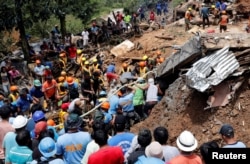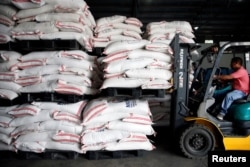After a super-typhoon killed 6,200 people five years ago, Filipinos figured the experience had taught their country a lesson. Pre-storm warnings and disaster responses should improve, then-president Benigno Aquino said.
This month another super-typhoon killed at least 74 when it set off landslides in the Philippine central mountain range.
Now officials are looking for ways to improve once again as they eye illegal mining and a glitch in the evacuation system as underlying causes of the deaths. Miners in the mountain village of Itogon refused to evacuate before Typhoon Mangkhut struck Saturday, the mayor was quoted as saying in domestic media.
The government should look too into the dangers of “uncontrolled” mining in general, President Rodrigo Duterte said on the presidential office website.
“I think what was lacking was on enforcement, the point where you don’t give them any choice anymore,” said Herman Kraft, a political science professor at the University of the Philippines Diliman in Metro Manila.
“And then another thing that reached the level of the president is the question about mining,” he said. “The question that’s being raised now is the extent to which mining companies have actually undermined the land.”
Evacuation system
Fifty-five people are missing in northern Luzon Island, where the world’s strongest tropical storm so far this year first struck.
In Itogon, Mayor Victorio Palangdan said people living in miners’ bunkhouses ignored warnings from police officers and disaster officials who tried to “move them out of harm’s way” last week, ABS-CBN News of the Philippines reported.
The government was “more systematic” than before in ordering evacuations, said Antonio Contreras, political scientist at De La Salle University in the Philippines. It was “very ready” and few deaths were reported outside mining areas, he added.
14 million affected
About 3 million Filipinos were affected in the worst hit regions, and another 11 million nearby braced for flooding. Mangkhut went on to topple trees and damage infrastructure in southern China, where four people died.
Typhoon Yolanda, called Haiyan internationally, brought storm surges higher than expected in 2013. People were slow to move that year, too.
Officials issued storm surge warnings that year, but “it appears that many residents and local authorities underestimated” the event and thought that they could evacuate at a later stage or during the storm itself,” according to a 2015 study in the International Journal of Sustainable Future for Human Security.
“The results clearly highlight the need for better education and for development strategies in the region to focus on improving the resilience of local inhabitants,” the study said.
Uncontrolled mining
Duterte said Monday “uncontrolled” mining contributed to landslides Saturday. Duterte was “anti-mining” since before the typhoon, Contreras said.
“We have a problem with the mining industry,” he said via the presidential office website. “It has not contributed anything substantial to the national economy. That mining thing has really contributed a lot of heartaches for the Filipino people.”
On Thursday a landslide near the Philippine city Cebu buried 24 houses and killed at least 21 people in another spot known for mining, domestic media outlets said. The typhoon did not reach Cebu but brought heavy rains to much of the country.
“The issue about the capacity of the state regulator to determine the safety of mining areas will now be in question and in doubt,” Contreras said.
Some Filipinos see mining as an underexplored way to stimulate the economy, held back so far mainly by environmental groups and debates about whether to let foreign investors take a share. Aquino had pushed for clearer mining regulation during his 2010-2016 term, when he made foreign investment a priority.
Rice prices keep surging
Saturday’s typhoon is also threatening to ruin the October 2018 rice harvest as it flooded prime Philippine cropland, Kraft said. Filipinos have paid more for rice, a national staple, since August as earlier 2018 storms and perceptions of a shortage raised consumer prices. Some blame the government for letting prices rise.
Philippine officials estimated earlier this week that Typhoon Mangkhut caused agricultural damage of $264 million.
“Devastating crop damage” would pressure poor farmers in part by leaving them too little money to buy next season’s seeds, said Rajiv Biswas, executive director and Asia-Pacific chief economist with the research firm IHS Markit.
“If this results in even higher inflation because of the loss of essential food items, particularly rice — rice prices have been rising quite rapidly already even before this typhoon — the damage of loss of rice production means that prices will probably go up even more,” Biswas said.










